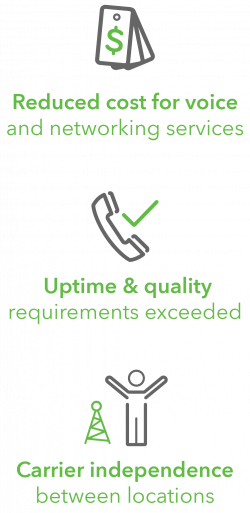Case Study: Allen Lund Company
Allen Lund removes network cost and complexity with Bigleaf SD-WAN
Customer profile
California-based Allen Lund Company is one of the nation’s premier third-party transportation brokers with more than 30 offices across the United States. The company employs more than 500 people and manages more than 300,000 dry, refrigerated and flatbed freight shipments a year
Business challenge
With offices distributed across the country and a business built on timely communication, Allen Lund relies on phones to do business. Over the last decade, the company has deployed a plethora of ad-hoc phone systems across its dispersed network. Allen Lund needed a unified dialing plan with centralized technology management to replace their legacy architecture built on policy-based technologies like IPSEC. To reduce complexity and cost, they sought a way to move their phone operations to the cloud without compromising on quality and uptime.
Solution
Bigleaf Cloud-first SD-WAN was the streamlined solution that delivered reliable uptime and call quality, even amidst the random failures of the Internet.


Allen Lund Company needed a network built for the future
Craig Borzelliere, manager of IT Systems and Infrastructure Department for Allen Lund Company, explains that the company’s business needs were becoming harder to meet with their current technology, requiring the logistics provider to move some of its most critical business applications to the cloud.
“We’ve been in business for 42 years. Over those four decades, we’ve relied on the quality and uptime of our network infrastructure, especially for critical areas of the business like our phone system,” said Borzelliere. With offices across the country and a business built on timely communication, Allen Lund relies on their phones to do business.
That reliance on quality and uptime came at a price. The company’s legacy architecture was becoming increasingly costly and complex. Meeting the needs of its growing business was becoming harder to achieve with the technology currently deployed across Allen Lund Company’s dispersed network.
Over the last decade, Allen Lund Company has deployed a plethora of ad-hoc phone systems across its business – Nortel at its headquarters, Panasonic in its Portland office, Vertical Networks at another.
Borzelliere wanted to move the company’s phone operations to the cloud but was concerned about the reliability of connectivity and the quality of cloud-based calls.
Borzelliere needed a unified dialing plan with centralized technology management. Allen Lund Company’s current architecture was built on policy-based technologies like IPSEC. Cisco’s Call Manager attempted to corral everything in the datacenter. Borzelliere embraced MPLS for quality of service while everything else traveled through the branch internet. This meant partnering with the big carriers, resulting in different levels of availability from location to location. As bandwidth became more of a commodity, Borzelliere turned to the cloud for a better way to manage Allen Lund Company’s infrastructure.
Bigleaf helped solve Allen Lund Company’s connectivity issues so they could have the quality and uptime they needed with the flexibility and cost savings the cloud provided.
When you’re on the cloud, uptime becomes a critical metric
With Allen Lund now relying on the cloud for their phones, one of its most important business applications, any disruption in Internet connectivity in one of its offices meant that office was out of business until the connection came back up. For Borzelliere, that meant unhappy customers, frustrated co-workers and lost revenue.
“If the phones go down, the company goes out of business,” Borzelliere said.
Internet uptime became a critical metric once Allen Lund Company was operating in the cloud. And while the cloud addressed Borzelliere’s concerns of complexity and cost, it added another: the random failures of their Internet connections.
As he started thinking about the company’s network and offices spread across the country – many of which were not located in huge metropolitan areas served by the company’s current providers — Borzelliere was faced with a new challenge: how to maintain service quality and network uptime when each location was working with its own local ISP.
Allen Lund Company’s operations were built around legacy technology. The tools were becoming antiquated and carrier support was less than optimal for the faster, nimbler world Allen Lund Company was now operating in. Moving to the cloud would be a monumental effort.
Borzelliere re-examined the company’s network architecture. One of Bigleaf’s business partners suggested he look at SD-WAN as an option. Borzelliere quickly realized that SD-WAN would give him the things he needed – carrier agnostic connections, better visibility through a single portal – and even things he didn’t know he’d need, such as intelligent network automation. SD-WAN would give Allen Lund Company the flexibility and cost savings of using multiple connections in aggregate. With an SD-WAN, Allen Lund Company could have multiple, carrier agnostic connections across multiple sites and use them all.
“Bigleaf knows its product and knows its customers. We know we’re in good hands. Bigleaf is everywhere for us
right now and will continue to be going forward because it’s easy, it’s working well and the cost is very reasonable”
–Craig Borzelliere,
Manager of IT Systems and Infrastructure, Allen Lund Company

Allen Lund went all-in on Bigleaf’s cloud-first SD-WAN
Flexibility was a priority for Allen Lund as it made the shift to the cloud. With its original telecom provider, the company was required to have a dedicated connection in every office, were only allotted a certain amount of lines and also had to keep an allotment of 6-12 POTS lines that they paid for as well. All of this complexity was channeled into a powerful, expensive Cisco router. It was incredibly complex and it worked, but the company was paying for lots of circuits, lots of lines and lots of hardware. As the company grew, the costs associated with this legacy approach grew with it, as did the complexity as availability was different from location to location.
“When it worked, we had all our traffic going through that router. But when the cable went out, which it frequently did, we had to manually failover to MLPS. It wasn’t attractive by any means, but it offered redundancy. We were paying a lot for antiquated tools, not getting great service and I knew there were better deals out there,” said Borzelliere.
Bigleaf Networks was the only SD-WAN solution that could provide the uptime, performance and reliability Borzelliere needed. The logistics provider replaced its expensive and complex Cisco router with Bigleaf’s cloud-first solution.
“Sometimes these bold solutions need a big pitch to executives to get buy-in and sign off,” said Borzelliere. “It’s hard enough explaining to non-technologists what these technologies do. Explaining cost makes it extra difficult. Going with Bigleaf made it easy because the cost wasn’t anywhere near the incredible value of such a powerful product.”
Bigleaf deployed routers to all of Allen Lund Company’s locations. The installation process consisted of plugging into the Bigleaf router and making a simple IP address change on the Allen Lund equipment. This immediately connected them to Bigleaf’s backbone network that enabled them to connect over multiple types of broadband connections at each location, giving each Allen Lund Company office an enterprise-grade connection to the cloud without the cost and complexity of a traditional enterprise networking solution. Once connected, Borzelliere was able to see exactly how the Internet circuits at each of the company’s offices were performing as well as the impact that Bigleaf had on performance and uptime.
Bigleaf provides the cloud ready internet Allen Lund needs
Bigleaf’s unique Site-to-Cloud Architecture links all of Allen Lund Company’s sites to the backbone of the Internet. So they’re always within a few hops from any cloud technology that they decide to use.
Bigleaf’s intelligent software creates a resilient and high-performance connection utilizing readily available Internet connections anywhere that Allen Lund Company does business. The Dynamic QoS feature automatically detects and prioritizes their most critical Cloud application traffic. The Intelligent Load Balancing feature ensures that those priority applications are routed over the ISP that will provide the best end-user experience. These autonomous decisions are made and implemented 10 times per second, ensuring uninterrupted application performance.
And because Bigleaf works autonomously, without the need for manual configurations or policies, Borzelliere and his team can roll out new applications and bring new sites online without worry. Bigleaf sees the change and makes any adjustments needed, no people required.
With Bigleaf, Allen Lund Company can grow faster in the cloud
Today, Bigleaf is installed in every Allen Lund Company site. A single monitor in his office allows Borzelliere to monitor site performance. And, importantly, Borzelliere says Bigleaf’s support team has been able to figure out any issue that has cropped up, even if it had nothing to do with Bigleaf technology.
“My system administrator was looking into some of the challenges of making disaster recovery work at scale, especially as our volume of XML traffic picks up. He wanted more control over the network to do that. As a manager, I understand the desire to do it yourself, but I’m also responsible for knocking down hurdles that get in the way of my team staying focused on solving the big problems. Bigleaf knocks down many of the barriers that have stood in our way,” said Borzelliere.
While there are other choices in the market, Borzelliere cautions that they come at a cost of managing and dealing with the resulting complexity. With Bigleaf, Allen Lund Company will be able to grow their company in the cloud without worrying about the random failures of the Internet.
“Bigleaf knows its product and knows its customers. We know we’re in good hands. Bigleaf is everywhere for us right now and will continue to be going forward because it’s easy, it’s working well and the cost is very reasonable.”